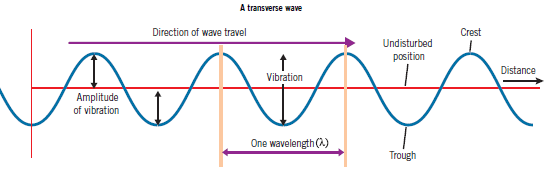sound wave
Sound is a variation in pressure.Sound is a mechanical wave that results from the back and forth vibration of the particles of the medium through which the sound wave is moving.
Compression and refraction
A region of increased pressure on a sound wave is called a compression (or condensation). A region of decreased pressure on a sound wave is called a rarefaction (or dilation).
crest-
A crest is the point on a wave with the maximum value of upward displacement within a cycle. A crestis a point on a surface wave where the displacement of the medium is at a maximum
Trought-A trough is the opposite of a crest, so the minimum or lowest point in a cycle.
Frequency:-
- The number of cycles or vibrations undergone during one unit of time.
- The symbols most often used for frequency are f and the Greek letters nu (ν) and omega (ω).
- The unit of frequency measurement is Hertz (Hz for short)
- Frequency is the speed of the vibration.
- this determines the pitch of the sound
wavelength:-
- the distance between successive crests of a wave, especially points in a sound wave.
- It is denoted by the Greek letter lambda (λ).
- it's SI unit is m(meter).
- it is equal to the speed (v) of a wave train in a medium divided by its frequency (f): λ = v/f.
- Wavelength is inversely proportional to frequency. This means the longer the wavelength, lower the frequency. In the same manner, shorter the wavelength, higher will be the frequency.
amplitude:-
Amplitude is measured by the maximum displacement of any point on the string from its position when the string is in equilibrium position..
this determines how loud the sound is.

The sine wave is given by-
y = Asinωt
where A= amplitude of sound,
ω= angular frequency of sound
t= time period
The sine wave is expressed as:
Y=Asin(ωt+Ф)
where- A = amplitude of the sine wave
Ф= Phase of the wave,
ω= angular frequency of the wave
t is time period.
sound wave can also be determine as ion general form-
Y(x,t)=Asin( ωt+kx+Ф) + C
where C is the non zero center amplitude.
Y= Asin(ωt+Ф)+K
where k= displacement costant.


Effect of temperature,pressure and volume on sound
The speed of sound is given by:
where- is the pressure and is the density of the gas. is a constant called the adiabatic index.
The equation should make intuitive sense. The density is a measure of how heavy the gas is, and heavy things oscillate slower. The pressure is a measure of how stiff the gas is, and stiff things oscillate faster.
let's consider the effect of temperature. When we heating the gas you need to decide if you're going to keep the volume constant and let the pressure rise, or keep the pressure constant and let the volume rise, or something in between. Let's consider the possibilities.
Case 1-
Suppose we keep the volume constant, in which case the pressure will rise as we heat the gas. That means in equation (1) increases while stays constant, so the speed of the sound goes up. The speed of sound is increasing because we're effectively making the gas stiffer.
Case 2-
Now suppose we keep the pressure constant and let the gas expand as it's heated. That means in equation (1) decreases while stays constant and again the speed of sound increases. The speed of sound is increasing because we're making the gas lighter so it oscillates faster.
Case 3-
Case 3-
And if we take a middle course and let the pressure and the volume increase thenincreases and decreases and again the speed of sound goes up.
Result-
Result-
So, increasing the temperature increases the speed of sound, but it does it in different ways depending on how we let the gas expand as it's heated.
motion of sound in different medium:-
In liquid:
The speed of sound is affected by density and viscosity. These in turn are affected by temperature, pressure, composition and currents (as with wind).
In solid:
The speed of sound waves traveling lengthwise is influenced by the density and flexibility of the material. These are affected by the composition of the material, the temperature, the crystalline structure if any, and any compression or tension in the material. Certain exotic materials such as piezoelectric materials have complex behavior.
The speed of sound waves traveling lengthwise is influenced by the density and flexibility of the material. These are affected by the composition of the material, the temperature, the crystalline structure if any, and any compression or tension in the material. Certain exotic materials such as piezoelectric materials have complex behavior.
Human hearing capacity-
- Humans are generally capable of hearing sounds between 20 Hz and 20 kHz (although I can't hear sounds above 13 kHz).
- Sounds with frequencies above the range of human hearing are called ultrasound.
- Sounds with frequencies below the range of human hearing are called infrasound.
- Typical sounds produced by human speech have freqeuncies on the order of 100 to 1,000 Hz.
- The peak sensitivity of human hearing is around 4000 Hz.



0 Comments